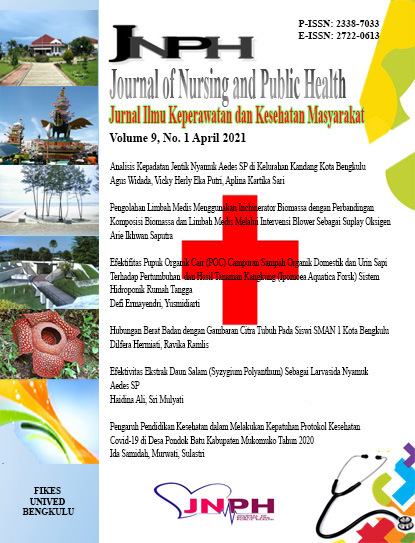FILTRASI AIR SUMUR GALI MENJADI AIR MINUM MENGGUNAKAN FILTER AIR (0.3 Μ DAN 0.1 Μ), FILTER FE DAN FILTER MN SERTA FILTER KARBON AKTIF
Abstract
Air merupakan kebutuhan pokok masyarakat untuk hidup dengan layak, sebagian besar akses masyarakat Kota Bengkulu masih menggunakan air sumur gali sebagai sarana penyediaan air bersih dirumah tangga yang kualitasnya masih rendah. Di era revolusi industry 4.0 telah banyak tersedia filter air berbagai ukuran. Proses filtrasi air sumur gali dengan memanfaatkan filter air hasil pabrikan, air sumur gali akan jauh lebih jernih. Tujuan penelitian ini adalah melakukan filtrasi air sumur gali menjadi air minum menggunakan filter air (0.3 µ, dan 0.1µ), filter Fe dan filter Mn serta filter Karbon Aktif. Jenis penelitian yang digunakan adalah deskriptif analitik, dengan 3 perlakuan dan 5 kali pengulangan.Analisis statistik dengan univariat, proses filtrasi air sumur gali dapat menjadi air minum sesuai Permenkes No. 492 tahun 2010. Hasil penelitian menunjukkan bahwa nilai rata-rata TDS = 207.6 mg/l, nilai rata-rata kekeruhan = 1.11 NTU, nilai rata-rata Fe = 0.003 mg/l, nilai rata-rata Mn = 0.002 mg/l dan tidak ditemukan bakteri E.coli (0/100 ml) pada air tersebut. Sehingga air hasil filtrasi ini dapat dijadikan sebagai air minum.
Downloads
References
Baker, R 2012, Microfiltration, in Membrane Technology and Applications, 3rd edn, John Wiley & Sons Ltd, California
Blog: Indowatershop.com
Chirhakarhula Emmanuel Chubaka. ID, Harriet Whiley. ID , John W. Edwards and Kirstin E. Ross. ID. 2018. Microbiological Values of Rainwater Harvested in Adelaide
Didik Budijanto. 2018. Situasi Balita Pendek (Stunting) di Indonesia. Buletin, Jendela Data dan Informasi Kesehatan, ISSN 2088-270X.
Dinas Kesehatan. 2016, 2017 dan 2018. Profil Kesehatan Prov. Bengkulu.
Dinas Kesehatan. 2017. Profil Kesehatan Kota Bengkulu.
Hakim. L. 2017. Lebih dalam membahas Jenis Teknologi Filter Karbon Akitif
http:/ianrpubs/unl.edu/water. Catridge Sediment. Neb Guide G.1492
https:// WWW. Mastah.Org/Ferrum.
https://www.lenntech.com/periodic/elements/mn.htm.Chemical properties of manganese - Health effects of manganese - Environmental effects of manganese.
Jubaidi, 2018. Effectiveness Of Water Filter With Circulation Method As A Control Of Larva Aedes Aegypti And Clean Water On Houselhold Enterprises. Advances in Health Sciences Research (AHSR) Vol. 14, 1st International Confrense Health Collaboration (ICIHC 2018)
Kusnedi.2010. Mengolah Air Kotor Untuk Air Minum. Jakarta: PenebarSwadaya
Lecture notes, Postgraduate course on Filtration and Size separation at the Department of Chemical Engineering, University of Lougborough, England
Limantara, LM. 2010. Hidrologi Praktis, Bandung CV. Lubuk Agung
Margono, 2010. Penyediaan Air Bersih. Poltekes Kemenkes Surabaya.
Menteri Kesehatan. RI. 2010. Permenkes No. 492/Menkes/PER/IV/2010 Tentang Persyaratan Kualitas Air Minum
Mulyadi.Tedi. 2016. Sains Teknologi. http://budisma.net
Rosborg, Ingederd. 2009. Health Aspects of minerals in drinking water Dep.Of Chemical Engineering, Lund Universty, Lund, Sweden
Said.NI., 1999. Cara Pengolahan Air Sumur Untuk Kebutuhan Rumah Tangga.BPPT. Jakarta
Sparks, Trevor; Chase, George (2015). Filters and Filtration Handbook (6thed.). Butterworth-Heinemann. ISBN 9780080993966)
Suprihanto, Notodamjo. 2005. Pencemaran tanah dan air tanah. Penerbit ITB. 2005
Sutrisno, Totok, 2010. Teknologi Penyediaan Air Bersih. Jakarta: Rineka Cipta
Syamsuddin, 2019.Kesehatan Lingkungan Teori dan Praktik. Penerbit Buku Kedokteraan. EGC
Wikikomponen. 2017. Pompa Air.http///wikikomponen.com
WHO.2011. Pedoman Mutu Air Minum. Jakarta. Penerbit Buku Kedokteran

An author who publishes in the Journal of Nursing and Public Health agrees to the following terms:
Author retains the copyright and grants the journal the right of first publication of the work simultaneously licensed under the Creative Commons Attribution-ShareAlike 4.0 License that allows others to share the work with an acknowledgement of the work's authorship and initial publication in this journal
Submission of a manuscript implies that the submitted work has not been published before (except as part of a thesis or report, or abstract); that it is not under consideration for publication elsewhere; that its publication has been approved by all co-authors. If and when the manuscript is accepted for publication, the author(s) still hold the copyright and retain publishing rights without restrictions. For the new invention, authors are suggested to manage its patent before published. The license type is CC-BY-SA 4.0.
Journal of Nursing and Public Health is licensed under a Creative Commons Attribution-ShareAlike 4.0 International License.
You are free to:
Share — copy and redistribute the material in any medium or format
Adapt — remix, transform, and build upon the material
for any purpose, even commercially.
The licensor cannot revoke these freedoms as long as you follow the license terms.









